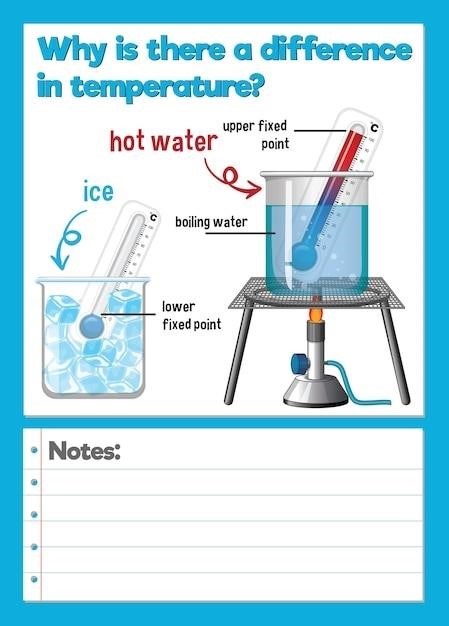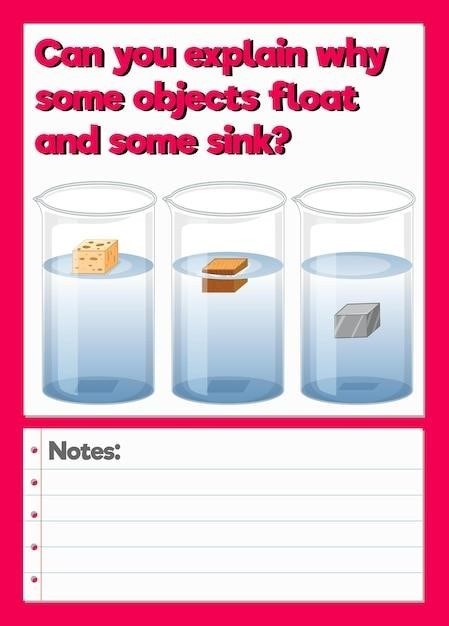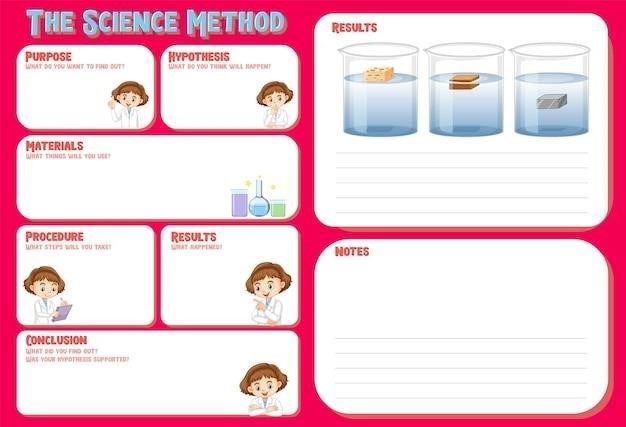Classifying Chemical Reactions⁚ Worksheet Answers
This worksheet provides answers for classifying various chemical reactions. It includes balanced equations and clearly identifies each reaction type⁚ synthesis, decomposition, single displacement, double displacement, and combustion; Detailed explanations are provided for each example to aid understanding. Refer to the accompanying worksheet for the original problems.
Types of Chemical Reactions
Chemical reactions are classified into several categories based on the types of changes occurring in the reactants. Understanding these categories is crucial for predicting reaction products and balancing chemical equations. Key reaction types include⁚
- Synthesis (Combination)⁚ Two or more substances combine to form a single, more complex product. A + B → AB. Example⁚ 2Na + Cl₂ → 2NaCl
- Decomposition⁚ A single compound breaks down into two or more simpler substances. AB → A + B. Example⁚ 2H₂O → 2H₂ + O₂
- Single Displacement (Replacement)⁚ One element replaces another element in a compound. A + BC → AC + B. Example⁚ Zn + 2HCl → ZnCl₂ + H₂
- Double Displacement (Metathesis)⁚ Two compounds exchange ions to form two new compounds. AB + CD → AD + CB. Example⁚ AgNO₃ + NaCl → AgCl + NaNO₃
- Combustion⁚ A substance reacts rapidly with oxygen, often producing heat and light. This usually involves organic compounds reacting with O₂ to produce CO₂ and H₂O. Example⁚ CH₄ + 2O₂ → CO₂ + 2H₂O
These classifications help organize and understand the vast array of chemical transformations.
Balancing Chemical Equations
Balancing chemical equations is a fundamental skill in chemistry, ensuring adherence to the law of conservation of mass. This law dictates that matter cannot be created or destroyed in a chemical reaction; the number of atoms of each element must be equal on both sides of the equation. Balancing involves adjusting coefficients (numbers placed before chemical formulas) to achieve this balance.
Consider the unbalanced equation⁚ H₂ + O₂ → H₂O. To balance this, we need two oxygen atoms on the product side, so we add a coefficient of 2 to H₂O⁚ H₂ + O₂ → 2H₂O. This now requires four hydrogen atoms on the reactant side, necessitating a coefficient of 2 for H₂⁚ 2H₂ + O₂ → 2H₂O. The equation is now balanced.
Balancing can be more complex with multiple reactants and products, often requiring systematic approaches and trial and error. However, the fundamental principle remains consistent⁚ ensure the number of atoms of each element is identical on both the reactant and product sides of the equation. This is crucial for accurate stoichiometric calculations and understanding reaction yields.
Synthesis Reactions
Synthesis reactions, also known as combination reactions, represent a fundamental type of chemical reaction where two or more reactants combine to form a single, more complex product. These reactions often involve the direct combination of elements or simpler compounds to create a more intricate molecule. A hallmark of synthesis reactions is the formation of a new substance with properties distinct from its constituent reactants.
A classic example is the formation of water from hydrogen and oxygen⁚ 2H₂ + O₂ → 2H₂O. Here, two simpler molecules, hydrogen gas and oxygen gas, combine to produce a more complex molecule, water. Another example involves the reaction of sodium and chlorine to form sodium chloride (table salt)⁚ 2Na + Cl₂ → 2NaCl. This reaction exemplifies the combination of two elements to yield an ionic compound.
Synthesis reactions are ubiquitous in chemistry and play a crucial role in various industrial processes and natural phenomena. Recognizing the pattern of multiple reactants combining to form a single product is key to identifying synthesis reactions in chemical equations, a skill emphasized in many chemistry worksheets and exercises.
Decomposition Reactions
Decomposition reactions represent the reverse of synthesis reactions. In a decomposition reaction, a single, more complex compound breaks down into two or more simpler substances. This breakdown often requires an input of energy, such as heat, light, or electricity, to overcome the bonds holding the compound together. The products of a decomposition reaction are typically simpler elements or compounds than the original reactant.
A common example is the decomposition of water into hydrogen and oxygen gases through electrolysis⁚ 2H₂O → 2H₂ + O₂. This process utilizes electricity to split the water molecule into its constituent elements. Another example is the thermal decomposition of calcium carbonate (limestone) into calcium oxide (lime) and carbon dioxide⁚ CaCO₃ → CaO + CO₂. This reaction requires heat to break down the calcium carbonate.
Decomposition reactions are crucial in various industrial processes, such as the production of metals from their ores and the breakdown of complex organic molecules. Understanding decomposition reactions is essential for mastering chemical reactions and interpreting chemical equations, as highlighted in many chemistry worksheets and practice problems focused on classifying reaction types.
Single Displacement Reactions
Single displacement reactions, also known as single replacement reactions, involve a reaction between an element and a compound. In this type of reaction, a more reactive element displaces a less reactive element from a compound. This displacement is driven by the relative reactivities of the elements involved, often determined by an activity series. The activity series provides a ranking of elements based on their tendency to lose electrons and undergo oxidation.
A classic example is the reaction between zinc metal and hydrochloric acid⁚ Zn(s) + 2HCl(aq) → ZnCl₂(aq) + H₂(g). Here, the more reactive zinc displaces the less reactive hydrogen from the hydrochloric acid, forming zinc chloride and hydrogen gas. The reaction proceeds because zinc is higher on the activity series than hydrogen. Similarly, a halogen (e.g., chlorine) can displace a less reactive halogen (e.g., iodine) from its salt. For instance, chlorine gas reacting with potassium iodide⁚ Cl₂(g) + 2KI(aq) → 2KCl(aq) + I₂(s).
Predicting whether a single displacement reaction will occur requires knowledge of the activity series and understanding the relative reactivities of the elements involved. This concept is frequently tested in chemistry worksheets and exams focused on classifying and balancing chemical equations.
Double Displacement Reactions
Double displacement reactions, also called double replacement reactions or metathesis reactions, involve the exchange of ions between two compounds. These reactions typically occur in aqueous solutions where the reactants are dissolved in water, and the driving force is often the formation of a precipitate (an insoluble solid), a gas, or a weak electrolyte (a substance that does not fully dissociate into ions in solution).
A common example is the reaction between silver nitrate (AgNO₃) and sodium chloride (NaCl)⁚ AgNO₃(aq) + NaCl(aq) → AgCl(s) + NaNO₃(aq). In this reaction, silver ions (Ag⁺) from silver nitrate combine with chloride ions (Cl⁻) from sodium chloride to form the insoluble silver chloride precipitate (AgCl), which separates from the solution. The remaining sodium (Na⁺) and nitrate (NO₃⁻) ions remain in solution as sodium nitrate (NaNO₃).
Another instance involves the formation of a gas. For example, the reaction of hydrochloric acid (HCl) with sodium carbonate (Na₂CO₃) produces carbon dioxide gas (CO₂)⁚ 2HCl(aq) + Na₂CO₃(aq) → 2NaCl(aq) + H₂O(l) + CO₂(g). The formation of the gas drives the reaction forward. Identifying the products as precipitates or gases is key to recognizing double displacement reactions. Worksheet problems often test the ability to predict products and balance such equations.
Combustion Reactions
Combustion reactions are rapid reactions that produce heat and light. They are characterized by the reaction of a substance with an oxidant, typically oxygen (O₂), to produce oxidized products. The most common combustion reactions involve the burning of organic compounds, such as hydrocarbons (compounds containing only carbon and hydrogen) and their derivatives. These reactions are exothermic, meaning they release energy in the form of heat and light.
A classic example is the combustion of methane (CH₄), the primary component of natural gas⁚ CH₄(g) + 2O₂(g) → CO₂(g) + 2H₂O(g). In this reaction, methane reacts with oxygen to produce carbon dioxide and water vapor. The balanced equation shows the stoichiometric ratios of reactants and products. Complete combustion of hydrocarbons generally produces carbon dioxide and water. However, incomplete combustion, often due to insufficient oxygen, can lead to the formation of carbon monoxide (CO) and soot (carbon particles), which are harmful pollutants.
Recognizing combustion reactions is relatively straightforward. The presence of oxygen as a reactant and the formation of carbon dioxide and water as products are strong indicators. Worksheet problems often involve balancing combustion equations, requiring careful attention to the stoichiometry to ensure conservation of mass. The heat released during combustion is crucial in many applications, from powering vehicles to generating electricity.
Identifying Reaction Types from Equations
Accurately identifying the type of chemical reaction from a given equation is a fundamental skill in chemistry. This involves analyzing the reactants and products to determine if the reaction fits the criteria for synthesis, decomposition, single displacement, double displacement, or combustion. Careful observation of the changes in chemical formulas is crucial.
Synthesis reactions involve the combination of two or more substances to form a single, more complex product. Decomposition reactions are the opposite; a single compound breaks down into two or more simpler substances. Single displacement reactions involve one element replacing another in a compound, while double displacement reactions involve the exchange of ions between two compounds.
Combustion reactions are characterized by rapid oxidation, typically involving oxygen as a reactant and producing oxides as products. Recognizing these patterns requires familiarity with the defining characteristics of each reaction type. Practice is key to developing proficiency. Worksheets provide valuable opportunities to reinforce this skill through repeated exposure to diverse chemical equations, strengthening your ability to analyze and classify reactions effectively.
Remember to always balance chemical equations before attempting classification; an unbalanced equation can obscure the true nature of the reaction. Accurate classification is essential for predicting reaction behavior and understanding chemical processes.

Activity Series and Single Displacement
Understanding the activity series of metals and nonmetals is essential for predicting the outcome of single displacement reactions. The activity series arranges elements in order of their reactivity, with the most reactive elements at the top. In a single displacement reaction, a more reactive element will displace a less reactive element from a compound.
For example, a more reactive metal will displace a less reactive metal from its salt solution. Similarly, a more reactive nonmetal will displace a less reactive nonmetal. Consulting the activity series allows you to predict whether a single displacement reaction will occur. If the element attempting displacement is less reactive than the element already in the compound, no reaction will take place.
The activity series is a valuable tool for analyzing and predicting the products of single displacement reactions. It provides a framework for understanding the relative reactivity of elements and their ability to displace other elements from compounds. This understanding is crucial for correctly classifying single displacement reactions and predicting their outcomes. Therefore, familiarity with the activity series is essential for mastering this area of chemistry.
The ability to utilize the activity series effectively is a key skill in predicting the products and feasibility of single displacement reactions, enabling a deeper comprehension of chemical reactivity and reaction prediction. This knowledge is critical for accurately completing worksheets and tackling more complex chemical problems.
Balancing and Classifying Practice Problems
This section focuses on practice problems designed to reinforce the skills of balancing chemical equations and classifying reaction types. The problems will present unbalanced chemical equations, requiring students to balance them before classifying the reaction type. This dual task strengthens both equation balancing skills and the ability to recognize the patterns characteristic of different reaction types.
The practice problems will encompass a variety of reaction types, including synthesis, decomposition, single displacement, double displacement, and combustion reactions. This diverse range ensures students gain proficiency across the spectrum of common chemical reactions. Each problem will present a unique challenge, requiring careful consideration of stoichiometry and reaction mechanisms.
Solutions will be provided to allow for self-assessment and identification of areas needing further attention. Detailed explanations will accompany each solution, outlining the steps involved in balancing the equation and the rationale behind the classification of the reaction type. This approach helps students not only obtain correct answers but also to develop a deep understanding of the underlying concepts.
By working through these practice problems, students will strengthen their problem-solving abilities and enhance their confidence in classifying chemical reactions. This section serves as a crucial stepping stone towards mastery of this fundamental chemistry concept.

Worksheet Examples and Solutions
This section presents a series of example problems, complete with detailed step-by-step solutions, to illustrate the process of classifying chemical reactions. Each example problem begins with an unbalanced chemical equation, showcasing the initial state before balancing. The solution then demonstrates the method used to balance the equation, emphasizing the importance of ensuring equal numbers of atoms of each element on both sides of the equation. This step-by-step approach clarifies the procedures involved and allows students to follow along easily.
Following the balanced equation, the solution clearly identifies the type of chemical reaction represented. This identification is supported by a concise explanation, highlighting the key features of the reaction that justify its classification. For instance, a synthesis reaction is characterized by the combination of two or more reactants to form a single product, whereas a decomposition reaction involves the breakdown of a single reactant into two or more simpler products. These explanations provide a comprehensive understanding of the underlying principles of classifying reactions.
The examples cover a range of reaction types, including synthesis, decomposition, single displacement, double displacement, and combustion reactions. This diverse selection ensures that students encounter various scenarios and develop a broad understanding of reaction classification. By carefully studying these examples and solutions, students can develop the skills needed to accurately classify chemical reactions independently.
Common Mistakes and Troubleshooting
A frequent error in classifying chemical reactions stems from neglecting to balance the chemical equation before attempting classification. An unbalanced equation can lead to misinterpretations of the stoichiometry and thus an incorrect classification. Always ensure the equation is balanced to accurately reflect the ratio of reactants to products. Another common mistake involves confusing similar reaction types, such as single and double displacement reactions. Carefully examine the reactants and products to identify whether one element is replacing another (single displacement) or if there’s an exchange of ions between two compounds (double displacement).
Difficulty in identifying combustion reactions often arises from overlooking the presence of oxygen as a reactant and the formation of carbon dioxide and water as products. Remember that combustion reactions are characterized by rapid oxidation, typically involving a fuel and oxygen, resulting in the release of energy. If you’re struggling to classify a reaction, review the definitions of each reaction type and systematically check for the characteristic features. Consider drawing diagrams or using visual aids to better understand the rearrangement of atoms and ions involved in the reaction;
Remember to consult a periodic table and activity series when working with single displacement reactions to determine the feasibility of a reaction based on the relative reactivities of the elements involved. If you encounter persistent challenges, seek clarification from your instructor or refer to additional learning resources such as online tutorials or textbooks for further assistance.




